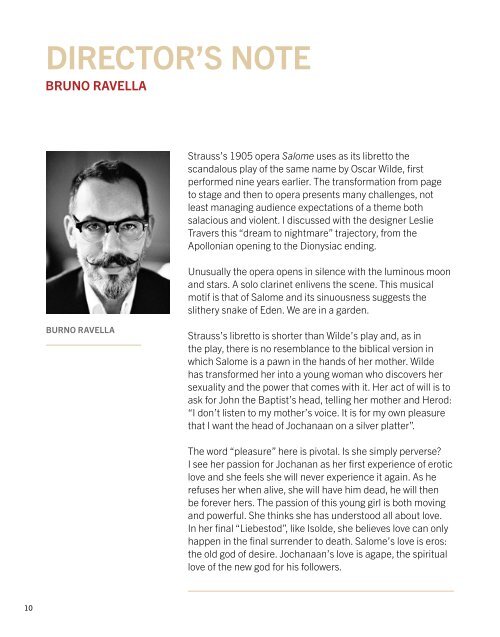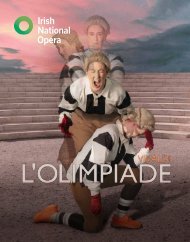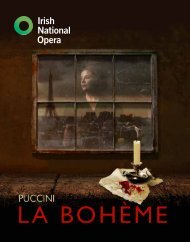Salome 2024 Programme
You also want an ePaper? Increase the reach of your titles
YUMPU automatically turns print PDFs into web optimized ePapers that Google loves.
DIRECTOR’S NOTE<br />
BRUNO RAVELLA<br />
BURNO RAVELLA<br />
Strauss’s 1905 opera <strong>Salome</strong> uses as its libretto the<br />
scandalous play of the same name by Oscar Wilde, first<br />
performed nine years earlier. The transformation from page<br />
to stage and then to opera presents many challenges, not<br />
least managing audience expectations of a theme both<br />
salacious and violent. I discussed with the designer Leslie<br />
Travers this “dream to nightmare” trajectory, from the<br />
Apollonian opening to the Dionysiac ending.<br />
Unusually the opera opens in silence with the luminous moon<br />
and stars. A solo clarinet enlivens the scene. This musical<br />
motif is that of <strong>Salome</strong> and its sinuousness suggests the<br />
slithery snake of Eden. We are in a garden.<br />
Strauss’s libretto is shorter than Wilde’s play and, as in<br />
the play, there is no resemblance to the biblical version in<br />
which <strong>Salome</strong> is a pawn in the hands of her mother. Wilde<br />
has transformed her into a young woman who discovers her<br />
sexuality and the power that comes with it. Her act of will is to<br />
ask for John the Baptist’s head, telling her mother and Herod:<br />
“I don’t listen to my mother’s voice. It is for my own pleasure<br />
that I want the head of Jochanaan on a silver platter”.<br />
The word “pleasure” here is pivotal. Is she simply perverse?<br />
I see her passion for Jochanan as her first experience of erotic<br />
love and she feels she will never experience it again. As he<br />
refuses her when alive, she will have him dead, he will then<br />
be forever hers. The passion of this young girl is both moving<br />
and powerful. She thinks she has understood all about love.<br />
In her final “Liebestod”, like Isolde, she believes love can only<br />
happen in the final surrender to death. <strong>Salome</strong>’s love is eros:<br />
the old god of desire. Jochanaan’s love is agape, the spiritual<br />
love of the new god for his followers.<br />
The set takes its inspiration from a medieval cistern. It suggests<br />
a claustrophobic space, a prison as well as a place in which the<br />
normal strictures of the palace do not apply. It is also a place<br />
of voyeuristic exploration. The verbs “to see”, “to watch” or “to<br />
look at” are used extensively throughout the text. We are keen<br />
to show how the viewer and viewed are organised in one space.<br />
This enclosed space contains opposing energies, those of insiders<br />
and outsiders, observer and observed, in which the audience is<br />
privileged to enter a private space but at the same time outside<br />
its power. When <strong>Salome</strong> meets Jochanaan for the first time we<br />
witness the confrontation of two worlds: the Old Testament, a<br />
world of corruption and decadence, and the New Testament in<br />
its original purity. We have a clash of two realities, that of the mind<br />
and that of the body. What attracts <strong>Salome</strong> to Jochanaan is his<br />
purity and his otherness from all she has known.<br />
The set also had to be as epic as the piece and to evolve to express<br />
the emotions at play. For <strong>Salome</strong>, Jochanaan opens up a world of<br />
possibilities. The claustrophobia connected with her situation turns<br />
to liberation and a feeling of space when she meets him. She offers<br />
herself to Jochanaan without any restraint. There is no strategy,<br />
just total sincerity. She is as true to her nature as he is to his.<br />
When he leaves her, she feels this as an existential abandonment.<br />
We were keen from the outset to use water for all its associations<br />
with the characters and the situation. In the cistern is Jochanaan,<br />
who through baptism, had the power to cleanse people of sin.<br />
Water is a symbol of purification in religious ceremonies. But it<br />
can also indicate the id, or what lies beneath, and is associated<br />
with the female element. An opera which starts with the moon,<br />
always associated with female power, ends with a grotesque<br />
display of that power.<br />
10<br />
11















